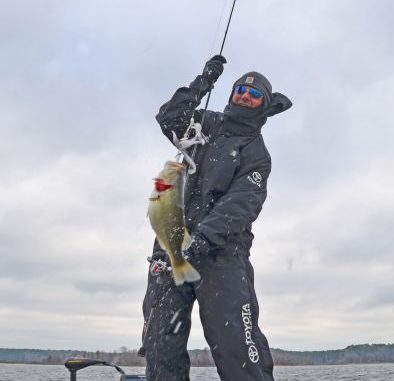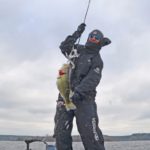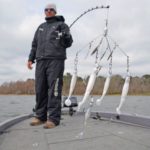
Want to get in on the big-bass fishing at Toledo Bend? This guide said Alabama rigs are great tools — if you have the proper gear and know how and where to fish them.
It felt like I was inhaling icicles. And I pulled my head back into my cozy, warm cabin at Big Bass Marina.
A vicious February cold snap had thundered down from Alberta the previous afternoon. The thermometer on my truck read 31 degrees when I arrived at the marina, and it had gotten even colder overnight.
I wondered what kind of guy I was fishing with. I knew he was one of about six full-time guides on south Toledo Bend, and my contact at the marina, Gene Stovall, had vouched for him as an expert with Alabama rigs.
“He’s a nice, clean-cut young person,” Stovall twanged. “As a fisherman, on a scale of 1 to 10, he’s a 9 and fixin’ to be a 10. He’s an expert at punching grass and fishing deep water where most people have trouble.
“When it’s good, anyone can catch them on spinners, but when it gets tough, Darold Gleason can find them and figure out how to make ‘em bite.”
Still ….
It was the day after a front, with 25 mph winds, and it was below freezing. The water puddles in the parking lot had frozen solid.
Perfect conditions to give bass a serious case of lockjaw.
Gleason was going to have to be good.
Or really lucky.
Or both.
At daylight, I met Gleason at the local grill/grocery/service station to grab a biscuit and cup of java. At 32 years old, he was slender, articulate and youthful-looking, in spite of his steel-gray hair and closely-cropped grizzled beard.
Not being in a particular hurry to rush into the semi-arctic conditions outside, I asked him about himself.
He said he from Leesville, and then with a chuckle added that he was really from Simpson.
“We only had 21 kids in my graduating high school class,” Gleason explained.
Tournament bass fishing got him started fishing deep structure, and he is still an active tournament fisherman. He fishes the Bassmaster Open, and in 2015 qualified to fish in the Elite Series’ BASSfest.
Gleason also fishes the statewide B.A.S.S. Nation circuit and, as much as his guiding schedule allows, participates in local team trails including Fishers of Men and Bass-N-Bucks.
And he’s pretty successful, paying off his college student loans with bass tournament winnings.
All too soon, however, I had to grab my quad parka and insulated boots, and follow him into the cold.
Because stiff northwest winds made fishing the eastern side of the lake unsafe, we sprinted around the bottom of the lake to the relatively protected waters of Six Mile Creek on the lake’s western side.
Thankfully, the boat ride from the landing was short and Gleason kept his fiberglass charger throttled back.
This arm of the lake, like all of the Bend’s branches off its main body, is the drowned bed and its surrounding lowlands of a creek that once feed into the Sabine River.
Six Mile is as large as some whole lakes elsewhere, and Gleason was fishing in its center, well away from easy landmarks.
Every creek arm, he explained, has its own characteristics. Some have more wood. Some have more grass. This one has extensive flats.
His planned strategy was to fish the 10- to 15-foot-deep edges of the 2- to 8-foot-deep spawning flats.
“That’s where they will be making love in two to three weeks,” Gleason explained. “The flats have strong stands of hydrilla on them, but in the winter it isn’t matted all the way to the surface.
“The bass will spawn on the inside edges of it. We are looking for big pre-spawn females moving out of deeper water onto the flats.”
Gleason said fishermen can find flats by looking on paper maps or by using Navionics GPS chips.
“But don’t focus on the flats themselves,” he explained. “Look for edges. Bass like edges of anything. They are ambush points.”
Once he was on his edge, it was a matter of watching his electronics and “simply” casting and retrieving.
Lesson one came quickly.
An A-rig is heavy. The harness is metal — light metal to be sure, but still metal. Add five jigheads weighing 1/8- or ¼-ounce. Then add five plastic tails.
So you’re chunking 2 ounces every time you cast.
On his short casts — and he didn’t make many — the rig sounded like a cast net hitting the water.
Gleason used a long, heavy rod and a sturdy reel. He hurled the lure with an action that looked more like a baseball bat swing than a cast.
“This is a big-fish lure,” he grunted as he cast. “You don’t want to throw this all day to catch 2-pound fish.
“I like to use it in the late winter/pre-spawn period and during the shad spawn, usually about May. That’s when largemouth bass gorge on shad.”
And the big girls will slam it.
“The reason I like it in the winter is that it is such a big-fish bait,” Gleason said. “It ups the chances of a big one, 5 pounds and above.
“But in comparison to other techniques, it’s strenuous.”
Besides being heavy, it isn’t a cheap bait to throw. Hang one up in a tree and it’s $30 gone.
Gleason picked up fish from the very beginning. It wasn’t a fast bite, but considering the conditions it was wonderful.
He fished with one or both hands bare. At least one stayed wet, landing and unhooking fish or stripping hydrilla from his lure.
He chuckled when I called the lure an Alabama rig.
“The proper name is an ‘umbrella rig,’” Gleason corrected. “The first guy who came out with one named his the Alabama Rig. The word ‘A-rig’ is just fishing slang.
“On my boat, we call it the five-splash rig because it makes five splashes.”
Cast followed cast with no breaks unless he was unhooking a fish. His retrieval was almost monotonously smooth.
“Try to fish right over the grass bed,” Gleason said. “You don’t want to provide any motion to the lure — just vary the speed of the retrieve to vary the depth.”
It’s a pretty simple technique. And there are detractors.
“Right now,” Gleason said, “bass sure are wild about it. Some people hate them, say it is too effective. It takes some of the skill out of fishing.
“Some tours have banned their use at the pro level, and some tournaments have limited the number of hooks. It’s only been out about 5 years now, so I think that it is still new enough that bass haven’t become conditioned to it yet.”
By 2:30 p.m. Gleason had boated enough bass to satisfy even the biggest skeptic.
Plus he had a very cold passenger. So we headed back to the relative warmth of our trucks.
By the time I reached Baton Rouge, the feeling had crept back into my toes.

